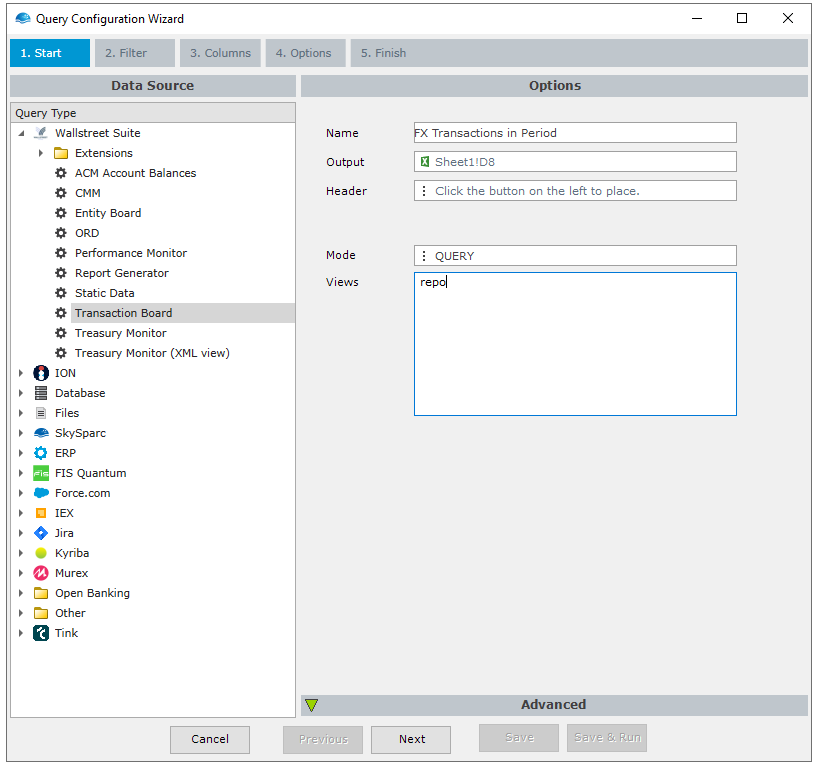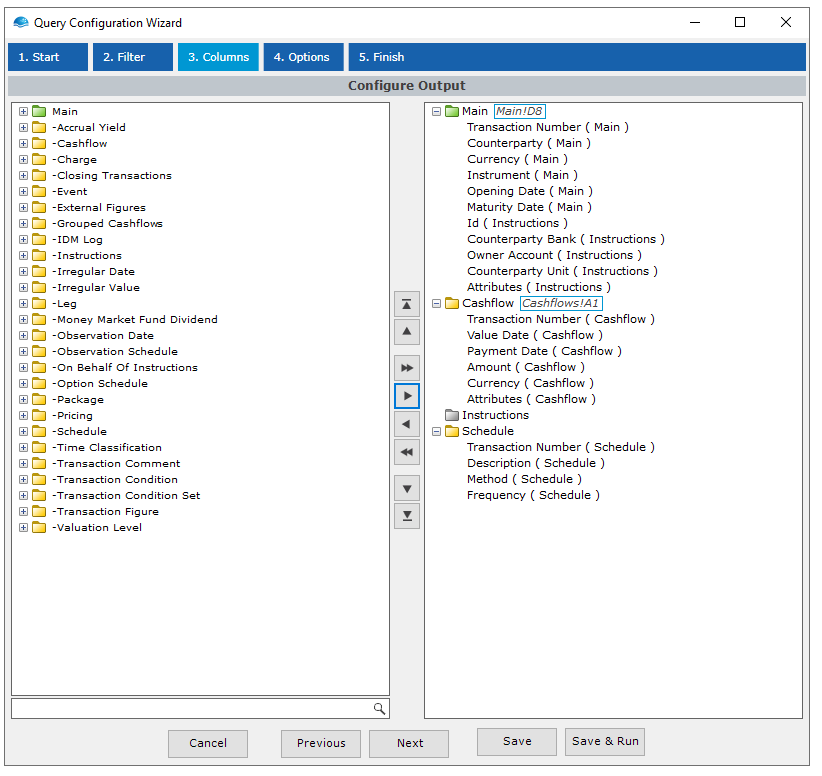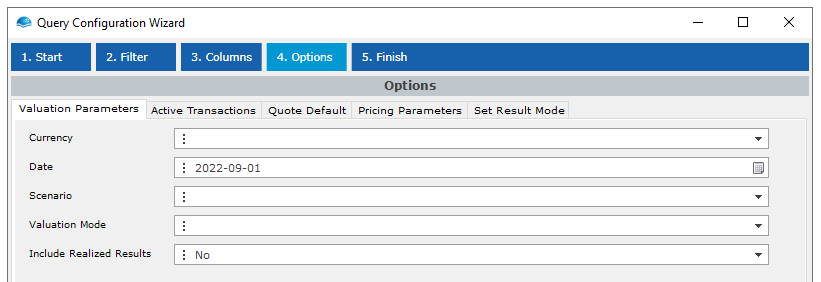Transaction Board
The Transaction Board Data Source is used to fetch information from the Wallstreet Suite Transaction Board. This source is useful when querying transaction details as well as transaction related information such as cashflows, settlement instructions and other transaction subentities.
It also supports querying transaction figures and calculated key figures.
To create a new Transaction Board query in the Query Configuration Wizard, follow these steps:
Step 1: Select Query Type
Select the Transaction Board query type from the list of data sources and optionally specify a name and output destination in the the top half of the Options page.

When querying data from the Transaction Board then you must also specify a Mode and View, which together corresponds to a specific transaction board layout, e.g. Deal Capture or Transaction Admin. The Mode generally determines what type of transaction that will be visible (e.g. ones in Verify, in Final or all) and the View determines which fields in the board are available (e.g. if the tab Repo is available or as a subentity).
The mode should generally be left to its default value of QUERY and specifying a view manually is not necessary unless you encounter that you are missing a Subentity when selecting fields to query.
Knowing what Mode/View to useIf you want to emulate a specific board then you can use the Application Manager in Wallstreet Suite to figure out what combination of Mode/View it uses.
Select an application while standing in the Detailed View and you can see the underlying command for the Transaction Manager; a Transaction Query Board uses for example the mode QUERY and half a dozen extra views while a Deal Capture board might use the mode TRADING.
Step 2: Define Query Criteria
The second step of the process is to define the Query Criteria or parameters for your query. The criteria will narrow down your query as fetching all transactions at once is generally not advised.
To define a a Query Criteria begin by selecting one or multiple columns that you want to filter on by toggling the checkbox next to them. Selecting multiple columns will create an AND statement.

Query Criteria that captures FX-SWAP and FX-FWD% transactions between 2022-09-01 and 2022-10-01.
After selecting your columns you can also optionally add an OR statement. This is done by right-clicking in the grid and selecting Add Row or pressing the down button while standing in the grid.
To remove a row you can right-click on it and select Delete Row and to remove a column you can press the X next to the header.

After the columns are added you can define values of the criteria by using the dropdown menu, typing them in manually or linking the criteria to a Parameter or Excel Reference.
More information about Parameterization can be found here: Parameterization
Any column values that are blank will be ignored.
Tip!You can use the same wildcards in OmniFi as in Wallstreet Suite, such as SKY% to fetch data for any Portfolio that begins with the prefix "SKY"
Step 3: Select Output Columns
The third step brings up the Configure Output window, which allows you to choose what fields to include in the query result.
The left-hand side contains a list of available fields while the right-hand side contains a list of selected fields. In both sides, fields are grouped according to the main entity and subentity, which can be collapsed and expanded.

Left panel contains available fields, right panel lists selected ones
Selecting and deselecting fields
There are several ways to select and deselect fields:
- Double-clicking on the field
- Dragging and dropping
- Using the left & right arrows icons in the middle between the two grids
- Using Keyboard Shortcuts
The added fields may be sorted by using the up & down arrow icons in the middle between the two grids or by dragging and dropping them in place.
Configuring output destination
After selecting fields to include you can optionally define an output destination if you want the data presented in Excel directly from the Query. Each individual dataset (main entity or subentity) can have its own output destination defined.
The output for subentities can be specified to be merged with or separated from the Main. If merged, the subentity results will be displayed together with the Main (see “Instructions” in the above figure), while if separated, the subentity results will be displayed in a separate location.
Merging or separating subentity outputs can be done by right clicking on the group name and choosing between
- Merge Output: merges the subentity output with the Main
- Separate Output: separates a merged subentity output from the Main
Configuring the output location of a separated subentity is done by right clicking on the group name and choosing between
- Place Output: selecting this option then clicking on a cell in the active Excel workbook allows you to choose the uppermost left corner of the display. Once chosen, the location will appear next to the name of the subentity to which it applies.
- Clear Output: clears the chosen location from Place Output
If subentities are separated but not given specific outputs (see “Schedule” in the figure below), the query results will be stored but not displayed.
The following figure illustrates an example of different output configurations for the main and the subentities.

In the figure, the output locations for Main and Cashflow are boxed in green. Cashflow and Schedule are separated from the main, while Instructions is merged. The output for Cashflow is defined, while that of Schedule remains blank. The popup box next to Schedule shows the four options described above when right-clicking on a subentity.
Step 4: Transaction Options
The Options window allows you to configure how calculations are made in the Transaction Board. They replicate the same options as in the Options tab in Transaction Board applications and should be used and populated in the same way.

Two particularly important tabs are
- Set Result Mode where the Result Mode is configured
- Valuation Parameters if any columns from Transaction Figure Group is chosen
Step 5: Finalizing the Query
Choose Save to save the query without running it, or Save & Run to save and execute the query. If query output is defined then you will see your output in Excel.
Updated 8 months ago